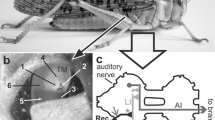Summary
-
1.
Peripheral nerves of catfish, Ictalurus, continued to conduct impulses at low temperatures but were blocked when the temperature approached zero. Nerves from fish acclimated to 24° were blocked at 3°, from fish acclimated to 10° were blocked at 1° C.
-
2.
Breathing movements of goldfish were conditioned to interruption by light as the conditioned stimulus and a shock as unconditioned stimulus. Individual goldfish showed much variability in rate of establishment of the conditioned response.
-
3.
After conditioning, the response could be interrupted, usually reversibly, by cooling. The temperature at which the conditioned response was lost, varied according to the temperature of conditioning, the blocking temperature rising approximately 5° for each 10° increase of conditioning temperature.
-
4.
The minimum temperature at which, conditioning could be established varied according to acclimation temperature. Fish acclimated to 15° could not be conditioned below 6–7° while those acclimated to 25° were not conditioned below 12–13°.
-
5.
The rate of change of minimum temperature for conditioning during acclimation was rapid, and required six to seventy-two hours. The time was longer for a large change in acclimation temperature than for a small change.
-
6.
It is concluded that one important component of temperature adaptation in fish consists of persistent alteration in capacity for central nervous integration.
Zusammenfassung
-
1.
Die peripheren Nerven des Katzenfisches Ictalurus können bis zu Temperaturen von etwa 0° C Impulse leiten. Bei Fischen, die an 24° C akklimatisiert waren, erlosch die Impulsleitfähigkeit bei 3°, bei an 10° C angepaßten Fischen jedoch erst bei 1°C.
-
2.
Auf einen elektrischen Schock stellen Goldfische ihre Atembewegungen kurzfristig ein —Unconditioned Stimulus —, durch Verknüpfung des elektrischen Reizes mit einem Lichtreiz — Conditioned Stimulus — konnten die Fische auf eine Unterbrechung der Atembewegungen dressiert werden. Die Dressurfähigkeit war bei den Goldfischen individuell sehr verschieden.
-
3.
Der Vollzug des bedingten Reflexes wird durch Abkühlen blockiert, normalerweise reversibel. Die Temperatur, bei der der Dressurerfolg verloren geht, hängt von der Dressurtemperatur ab, und zwar tritt bei einem Erhöhen der Dressurtemperatur um 10° der Kälteblock des bedingten Reflexes bei einer ungefähr 5° höheren Temperatur auf.
-
4.
Die minimale Dressurtemperatur ändert sich mit der Akklimatisierungstemperatur; an 15° angepaßte Fische können nicht unter 6–7°, an 25° akklimatisierte Fische nicht unter 12–13° dressiert werden.
-
5.
Die Änderung der minimalen Dressurtemperatur durch einen Wechsel der Adaptationstemperatur erfolgt schnell, sie benötigt ungefähr 6 bis 72 Std. Die Umstellung dauert länger bei einem großen Sprung in der Akklimatisierungstemperatur und bei einem Umsetzen der Tiere von warmen in die tiefe Temperaturen.
-
6.
Für die Temperaturadaptation der Fische sind langandauernde Änderungen des Integrationsvermögens ihres Zentralnervensystems sehr wichtig.
Similar content being viewed by others
References
Battle, H. I.: Effects of extreme temperatures on muscle and nerve tissues in marine fishes. Trans roy. Soc. Can., Sect. III, 20, 127–143 (1926).
Boyd, E. S., and L. C. Gardner: Positive and negative reinforcement from intracranial stimulation of a teleost. Science 136, 648–649 (1962).
Chatfield, P. O., C. P. Lyman, and L. Irving: Physiological adaptation to cold of peripheral nerve in the leg of the herring gull (Larus argentatus). Amer. J. Physiol. 172, 639–644 (1953).
Fisher, K. C.: An approach to the organ and cellular physiology of adaptation to temperature in fish and small mammals. In: Physiological adaptation, ed. by C. L. Prosser, p. 3–49. Washington: Amer. Physiol. Soc. 1958.
Geller, I.: Conditioned anxiety and punishment effects on operant behavior of goldfish. Science 141, 351–353 (1963).
Hashimura, S., and E. B. Wright: Effect of ionic environment on excitability and electrical properties of single nerve fibers of frog. J. Neurophysiol. 21, 24–44 (1958).
Li, C. L., and P. Gouss: Effect of cooling on neuromuscular transmission in frog. Amer. J. Physiol. 192, 464–470 (1958).
Miller, L. R., and L. Irving: Alteration of peripheral nerve function in rat after outdoor cold exposure. Amer. J. Physiol. 204, 359–362 (1963).
Otis, L. S., J. A. Cerf, and G. J. Thomas: Conditioned inhibition of respiration and heart rate in the goldfish. Science 126, 263–264 (1957).
Prosser, C. L.: Changes in cold-block of fish nervous systems by acclimation. Amer. Zool. 2, 549 (1962).
Ribbands, C. R.: Changes in the behavior of honey-bees following their recovery from anesthesia. J. exp. Biol. 27, 302–310 (1950).
Roots, B. I., and C. L. Prosser: Temperature acclimation and the nervous system in fish. J. exp. Biol. 39, 617–629 (1962).
Rozin, P.N., and J. Mayer: Thermal reinforcement and thermoregulatory behavior in the goldfish, Carassius auratus. Science 134, 942–943 (1961).
Sanders, F. K.: Second order olfactory and visual learning in optic tectum of goldfish. J. exp. Biol. 17, 416–434 (1940).
Author information
Authors and Affiliations
Additional information
This research was supported in part by grant G-8795 from the National Science Foundation.
A preliminary summary was published by Prosser (1962).
Rights and permissions
About this article
Cite this article
Prosser, C.L., Farhi, E. Effects of temperature on conditioned reflexes and on nerve conduction in fish. Zeitschrift für vergleichende Physiologie 50, 91–101 (1965). https://doi.org/10.1007/BF00388054
Received:
Issue Date:
DOI: https://doi.org/10.1007/BF00388054




